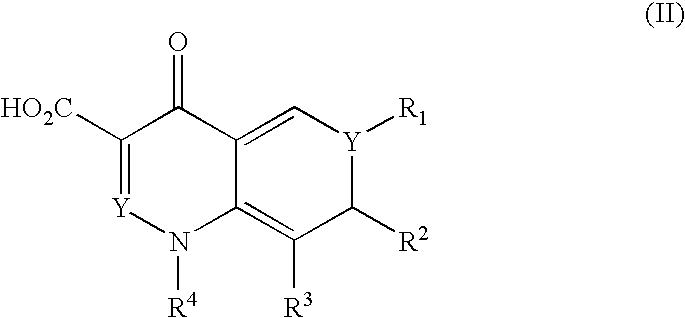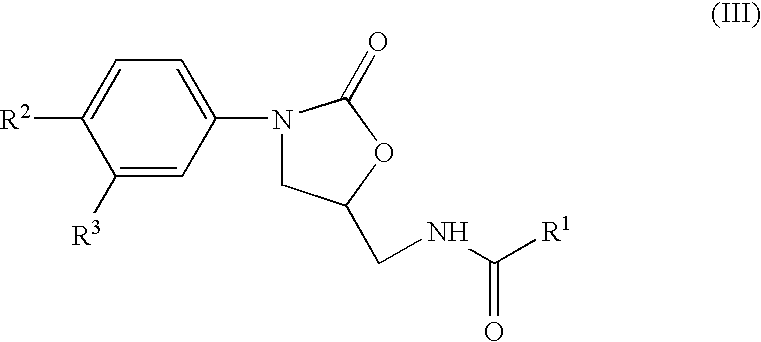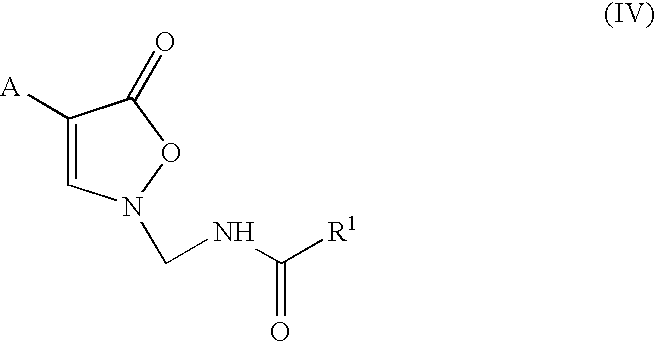Antimicrobial quinolone derivatives and use of the same to treat bacterial infections
a technology of oxazolidinone and quinolone, which is applied in the direction of antibacterial agents, group 3/13 element organic compounds, drug compositions, etc., can solve the problems of inability to administer oxazolidinone as an injection solution, the increase in bacterial resistance to existing antibacterial agents is a major clinical problem, and the effect of oxazolidinones not being active against gram
- Summary
- Abstract
- Description
- Claims
- Application Information
AI Technical Summary
Problems solved by technology
Method used
Image
Examples
example 1
Preparation of 7-[4-[(5-(S)-Acetamidomethyloxazolidine-2-one-3-yl)-2-fluorophenyl]piperazine-1-yl]-3-carboxy-1-cyclopropyl--6-fluoro-1,4-dihydroquinoline-4-one (Compound 3)
Compound 3 was prepared from 5-(S)-aminomethyl-3-(3-fluoro-4-piperazinophenyl)oxazolidine-2-one (0.372 g, 1.1 mmol) and 3-carboxy-1-cyclopropyl-7-chloro-6-fluoro-1,4-dihydroquinoline-4-one (0.282 g, 1 mmol) according to the General Procedure for the Synthesis of Quinolone-7-yl Linked Oxazolidinones. The-reaction was performed at 120° C. for 96 h. Yield 0.36 g (62%). MS(m / z): 582 [M+H]+. Rt 4.6 min.
example 2
Preparation of 10-[4-[(5-(S)-Acetamidomethyloxazolidine-2-one-3-yl)-2-fluorophenyl]piperazine-1-yl]-6-carboxy-9-fluoro-2,3-dihydro-3-methyl-7-oxo-7H-pyrido[1,2,3-de]-1,4-benzoxazine (Compound 6)
Compound 6 was prepared from 5-(S)-aminomethyl-3-(3-fluoro-4-piperazinophenyl)oxazolidine-2-one (0.372 g, 1.1 mmol) and 9.10-difluoro-2,3-dihydro-3-methyl-7-oxo-7H-pyrido[1,2,3-de]-1,4-benzoxazine-6-carboxylic acid (0.281 g, 1 mmol) according to the General Procedure for the Synthesis of Quinolone-7-yl Linked Oxazolidinones. The reaction was performed at 110° C. for 24 h. Yield 0.444 g (74%). MS (m / z): 598 [M+H]+. Rt 4.5 min. The separation of enantiomers by chiral HPLC provides the preferred (S)-configuration isomer.
example 3
Preparation of 7-(4{(5S)-5-[(Acetylamino)methyl]2-oxo-1,3-oxazolidin-3-yl}-2-fluorophenyl)-1-cyclopropyl-6-fluoro-4-oxo-1,4-dihydro-3-quinolinecarboxylic acid (Compound 11)
Benzyl-1-cyclopropyl-6-fluoro-4-oxo-7-{[(trifluoromethyl)sulfonyl]oxy}-1,4-dihydro-3-quinolinecarboxylate (Compound 7a)
A slurry of 1-cyclopropyl-6-fluoro-4-oxo-7-hydroxy-1,4-dihydro-3-quinolinecarboxylate (1.51 g, 5.75 moles), prepared as described in Kiely, J. S.; Laborde, E,; Lesheshki, L. E.; Busch, R. A. J. Heterocyclic Chem. 1991, 28, 1581-1585, in dry pyridine (15 mL) was cooled to 0E C and treated via syringe with trifluoromethanesulfonic anhydride (2.5 mL, 14.86 moles). The resulting homogeneous, amber-colored solution was warmed slowly to room temperature and stirred for 24 hours. Benzyl alcohol (20 mL, 193.3 moles) was added, and the reaction stirred at room temperature for 2 hours. After pouring the solution into 100 mL of water, the aqueous phase was extracted (3×) with CH2Cl2. The combined organic lay...
PUM
| Property | Measurement | Unit |
|---|---|---|
| pKa | aaaaa | aaaaa |
| general structure | aaaaa | aaaaa |
| bacterial resistance | aaaaa | aaaaa |
Abstract
Description
Claims
Application Information
 Login to View More
Login to View More - R&D
- Intellectual Property
- Life Sciences
- Materials
- Tech Scout
- Unparalleled Data Quality
- Higher Quality Content
- 60% Fewer Hallucinations
Browse by: Latest US Patents, China's latest patents, Technical Efficacy Thesaurus, Application Domain, Technology Topic, Popular Technical Reports.
© 2025 PatSnap. All rights reserved.Legal|Privacy policy|Modern Slavery Act Transparency Statement|Sitemap|About US| Contact US: help@patsnap.com



